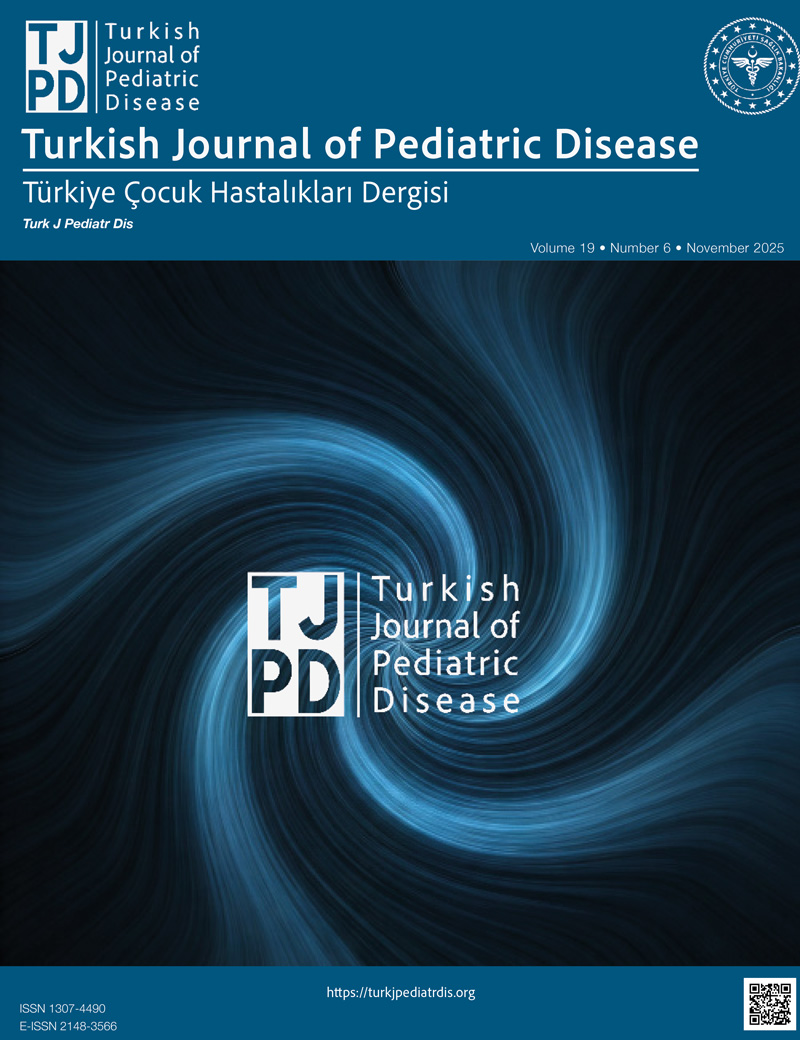Abstract
Objective: Intussusception is a prevalent etiology of emesis and abdominal discomfort in pediatric patients. This investigation sought to elucidate the correlation between epidemiological factors, clinical progression, diagnostic procedures, therapeutic interventions, and patient outcomes, with particular emphasis on the safety profile of hydrostatic reduction in subjects presenting with intussusception.
Material and Methods: In this retrospective study, we analyzed the data of children who were diagnosed and treated for intussusception in the hospital database and the Picture Archiving and Communication Systems (PACS) from January 2013 to December 2023. Demographic data, symptoms at presentation, mode of diagnosis, treatment modality, and associated complications were also recorded.
Results: Of the 165 patients, 60% were boys and 40% were girls, with a mean age of 35.5 years (1-193 months). Of the patients, 44.2% (n= 73) were presented within 24 hours of symptom onset. All patients had abdominal pain, and 24 (14.5%) had the classic triad of abdominal pain, vomiting, and red stools. Ultrasonography-guided hydrostatic reduction (USHR) and surgery resulted in a cure in 134 (93.3%) and 31 (6.7%) patients, respectively. The overall recurrence rate was 16.3%, with no mortality. There was a statistically significant difference between the length of the invaginated segment (4 cm or more) and USHR (p=0.004).
Conclusion: The USHR of invagination is effective regardless of the duration of symptoms and number of recurrences.
Keywords: Child, intestinal obstruction, intussusception, surgery, ultrasonography
References
- Waseem M, Rosenberg HK. Intussusception. Pediatric Emergency Care. 2008; 24(11):793-800. https://doi.org/10.1097/PEC.0b013e31818c2a3e
- Applegate KE. Intussusception in children: evidence-based diagnosis and treatment. Pediatric Radiology. 2009 ;39(S2):140-43. https://doi.org/10.1007/s00247-009-1178-9
- Charles T, Penninga L, Reurings JC, Berry MCJ. Intussusception in Children: A Clinical Review. Acta Chirurgica Belgica. 2015 ;115(5):327-33.https://doi.org/10.1080/00015458.2015.11681124
- Kim YG CBYKKJ. Diagnosis and treatment of childhood intussusception using rea-time ultrasonography and saline enema: preliminary report. J Korean Soc Med Ultrasound. 1982;1(1):66-70
- Jiang J, Jiang B, Parashar U, Nguyen T, Bines J et al. Childhood Intussusception: A Literature Review. PLOS One. 2013 ;8(7): e68482. https://doi.org/10.1371/journal.pone.0068482
- Guo W liang, Zhang S feng, Li J en, Wang J. Association of Meteorological Factors with Pediatric Intussusception in Subtropical China: A 5-Year Analysis. PLOS One. 2014 ;9(2): e90521. https://doi.org/10.1371/journal.pone.0090521
- Ito Y, Kusakawa I, Murata Y, Ukiyama E, Kawase H, et al. Japanese guidelines for the management of intussusception in children, 2011. Pediatr Int. 2012 ;54(6):948-58. https://doi.org/10.1111/j.1442-200X.2012.03622_1.x
- Talabi AO, Famurewa OC, Bamigbola KT, Sowande OA, Afolabi BI et al. Sonographic guided hydrostatic saline enema reduction of childhood intussusception: a prospective study. BMC Emerg Med. 2018 ;18(1):46. https://doi.org/10.1186/s12873-018-0196-z
- Charles T, Penninga L, Reurings JC, Berry MCJ. Intussusception in Children: A Clinical Review. Acta Chir Belg. 2015 ;115(5):327-33. https://doi.org/10.1080/00015458.2015.11681124
- Hangfei Jin W Du. Multiple Intussusceptions after Blunt Abdominal Trauma in a 5-Year-Old Boy: Case Report and Review of Nine Cases Reported in the Literature. Indian Journal of Surgery. 2021; 83:204-06. https://doi.org/10.1007/s12262-019-02067-z
- Kaiser AD, Applegate KE, Ladd AP. Current success in the treatment of intussusception in children. Surgery. 2007 ;142(4):469-77. https://doi.org/10.1016/j.surg.2007.07.015
- Wong CW, Chan IH, Chung PH, Lan LC, Lam WM et al. Childhood intussusception: 17-year experience at a tertiary referral centre in Hong Kong. Hong Kong Med J. 2015 ;21(6):518-23. https://doi.org/10.12809/hkmj144456
- Chung JL, Kong MS, Lin JN, Wang KL, Lou CC et al. Intussusception in infants and children: risk factors leading to surgical reduction. J Formos Med Assoc. 1994;93(6):481-5.
- Hryhorczuk AL, Strouse PJ. Validation of US as a first-line diagnostic test for assessment of pediatric ileocolic intussusception. Pediatric Radiol. 2009 ;39(10):1075-79. https://doi.org/10.1007/s00247-009-1353-z
- Hwang J, Yoon HM, Kim PH, Jung AY, Lee JS et al. Current diagnosis and image-guided reduction for intussusception in children. Clin Exp Pediatr. 2023 ;66(1):12-21. https://doi.org/10.3345/cep.2021.01816
- Sun Z, Song G, Lian D, Zhang Q, Dong L. Process Management of Intussusception in Children. Pediatr Emerge Care. 2022 ;38(7):321-25. https://doi.org/10.1097/PEC.0000000000002700
- Xiaolong X, Yang W, Qi W, Yiyang Z, Bo X. Risk factors for failure of hydrostatic reduction of intussusception in pediatric patients. Medicine. 2019 ;98(1): e13826. https://doi.org/10.1097/MD.0000000000013826
- Digant SM. Ultrasound Guided Reduction of an Ileocolic Intussusception by a Hydrostatic Method by Using Normal Saline Enema in Paediatric Patients: A Study of 30 Cases. J Clin Diagn Res. 2012 ;6(10):1722-5. https://doi.org/10.7860/JCDR/2012/4315.2650
- Daneman A, Navarro O. Intussusception. Pediatr Radiol. 2004 ;34(2):97-108. https://doi.org/10.1007/s00247-003-1082-7
- Beres AL, Baird R. An institutional analysis and systematic review with meta-analysis of pneumatic versus hydrostatic reduction for pediatric intussusception. Surgery. 2013 ;154(2):328-34. https://doi.org/10.1016/j.surg.2013.04.036
- Navarro O, Daneman A. Intussusception. Pediatr Radiol. 2004 ;34(4):305-12. https://doi.org/10.1007/s00247-003-1028-0
- Ko HS, Schenk JP, Tröger J, Rohrschneider WK. Current radiological management of intussusception in children. Eur Radiol. 2007 ;17(9):2411-21. https://doi.org/10.1007/s00330-007-0589-y
- Champoux AN. Recurrent Intussusception. Arch pediatr adolesc med.1994;148(5):474-78. https://doi.org/10.1001/archpedi.1994.02170050032006
- Purenne E, Franchi‐Abella S, Branchereau S, Baujard C, Benhamou D et al. General anesthesia for intussusception reduction by enema. Pediatric Anesth. 2012 ;22(12):1211-5. https://doi.org/10.1111/pan.12035
- Sáez-Llorens X, Velázquez FR, Lopez P, Espinoza F, Linhares AC et al. A multi-country study of intussusception in children under 2 years of age in Latin America: analysis of prospective surveillance data. BMC Gastroenterol. 2013 ;13(1):95. https://doi.org/10.1186/1471-230X-13-95
- Samad L, Marven S, El Bashir H, Sutcliffe AG, Cameron JC et al. Prospective surveillance study of the management of intussusception in UK and Irish infants. Br J Surg. 2012 ;99(3):411-5. https://doi.org/10.1002/bjs.7821
- Pazo A, Hill J, Losek JD. Delayed Repeat Enema in the Management of Intussusception. Pediatr Emerg Care. 2010 ;26(9):640-5. https://doi.org/10.1097/PEC.0b013e3181ef0426
- Shekherdimian S, Lee SL. Management of pediatric intussusception in general hospitals: diagnosis, treatment, and differences based on age. World J Pediatr. 2011 ;7(1):70-3. https://doi.org/10.1007/s12519-011-0249-9
- Ekenze S, Mgbor S. Childhood intussusception: The implications of delayed presentation. Afr J Paediatr Surg. 2011;8(1):15-8. https://doi.org/10.4103/0189-6725.78662
Copyright and license
Copyright © 2025 The Author(s). This is an open access article distributed under the Creative Commons Attribution License (CC BY), which permits unrestricted use, distribution, and reproduction in any medium or format, provided the original work is properly cited.






